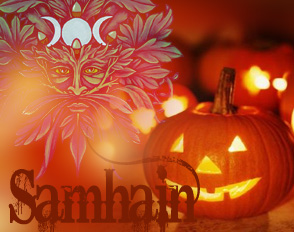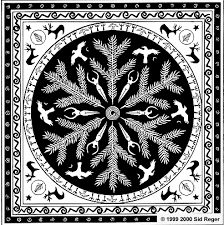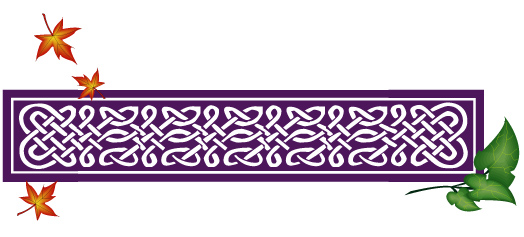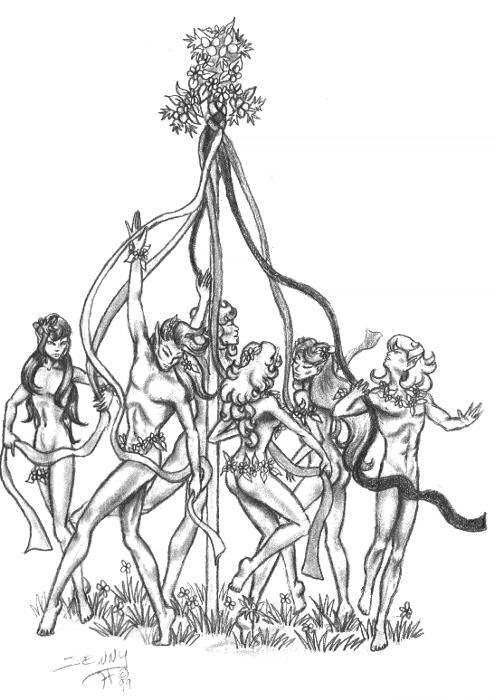May is perhaps one of the most exciting monts of the year, as the bright and joyful birthing energy of spring blossoms into vigorous excitement this month. The newness of life bursts into eager exuberance. The world is growing, stretching, and reaching out to find the wild and extravagant love and erotic sensation. It is the perfection of being in the moment, a time of happiness and fervor.
The month of May brings the Roman festival of Maia, goddess of growth and abundance for whom this month is named; Flora, goddess of springtime and flowers, and Rosalia, the Festival of Roses. The Irish celebrate the Veneration of the Sacred Thorn, and the Norse, the Feast of Frigg. There’s Garland Day in England, Lei Day in Hawaii, and of course, the Celtic celebration of Beltane–a festival already in full swing when the month arrives.
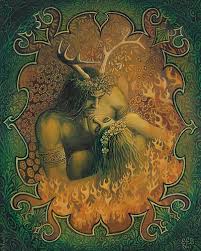 The rythm of our bodies and hearts instinctively feel the tempo of the wild universe, which opens its arms and embraces us as we flow in with laughter and joy. The perfect, unalloyed pleasure of being is the Beltane state of mind. We flow into this state of mind when we dance in harmony with the ecstatic universe. We let go of our petty selves and step into that flow of harmonious union to become ecstatic ourselves. We embrace our wildness.
The rythm of our bodies and hearts instinctively feel the tempo of the wild universe, which opens its arms and embraces us as we flow in with laughter and joy. The perfect, unalloyed pleasure of being is the Beltane state of mind. We flow into this state of mind when we dance in harmony with the ecstatic universe. We let go of our petty selves and step into that flow of harmonious union to become ecstatic ourselves. We embrace our wildness.
Often, it’s difficult for us to emerge as ecstatic, wild, nature beings. One avenue to emergence is to celebrate a deity. Flora, the Roman goddess of springtime and flowering vegetation, is a good choice for the Beltane state of mind. She is the patroness of everything that grows and flourishes: flowers, plants, trees and vines. Her festival, Floralia, was celebrated from April 28 to May 3, and in a rose festival on May 23, though much of the orgiastic celebrations were eventually outlawed. Nevertheless, we can find her ecstatic magic in our bodies and in the blooming flowers.
Each event is a fertility festival in which plants and flowers play a very important role. It is a real pity that their role as magical tools is frequently overlooked. Because they are capable of something wonderful. Flowers are capable of speaking real words that soar straight into the universe in a very special but secretive language called Floriography — the language of flowers.
Beltaine
(April 30th – May 1st)
Also known as Roodmas, Beltaine has long been celebrated with feasts and rituals. Beltane means fire of Bel; Belinos being one name for the Sun God, whose coronation feast we now celebrate. Beltane is also commonly known as May Day, “may” coming from “maiden”, representing the Goddess in Her Maiden aspect. The name Beltane is sometimes incorrectly assigned to Litha, the holiday of Mid-Summer, by some modern traditions of Wicca, even though Beltane is the Gaelic word for May.
Halfway around the year from Samhain, when we honor our beloved dead, Beltane is the festival that celebrates all of the living world: plants, animals, and human beings. On both occasions, the veil between the worlds is said to be thin, and is no more unusual to see the fairies near Beltane, than it is to see the spirits of the dead at Samhain. Beltane is also the great spring holiday of the Goddess. It is a time of Faerie Magic and the Queen of faeries is represented by the Queen of the May. Along with her consort, she rules over the festivities and serves as representative of the Goddess.
In most temperate climates, flowers are now in bloom, trees are in blossom or in full leaf, and gardens are beginning to grow. All of the hibernating animals are fully awake. The birds have nested and settled down to raise their brood.
Beltane is the Holiday of fertility. For Pagans, one of the great gifts of the Goddess is the power of the earth to grow wonderful flowers and fruits and all the things we eat. We are thankful for the fertility of the earth, and our job is to keep the land and the soil healthy, to protect the animals and plants and trees so that fertility can continue. The earth is a living being, and all of her creatures are part of her body. Each has a place, a purpose, a special part in the great dance of life.
As summer begins, just as the weather becomes warmer, and the plant world blossoms, an exuberant mood prevails. At Beltaine we celebrate the joys of being alive. We give thanks for all the different kinds of pleasure our bodies give us, for without our bodies we couldn’t see, hear, touch, taste, smell, run, dance, jump or do any of the things we do. Children celebrate by doing all the things they can do which they couldn’t do before — run, jump, play games, climb trees, dance, turn somersaults and cartwheels or anything that makes them glad they have a body. Adults celebrate sexual pleasure. For Pagans, the good, loving feelings that people can give each other with their bodies are special gifts of the Goddess. When we give each other love and pleasure, the whole earth is pleased. We give thanks for the power women and men have to make babies and bringing new people into the world.
In old Celtic traditions Beltane was a time of unabashed sexuality and promiscuity where marriages of a year and a day could be undertaken but it is rarely observed in that manner in modern times.
On this day all the different kinds of human fertility and creativity are celebrated and thanked for. Not only pro-creation, but we create in many other ways as well. When we paint, draw or sculpt, when we write poems, songs or stories, when we garden, cook or bake, we take part in the fertility of the Goddess.
In the old Celtic times, Bel-fires were lit on hilltops to celebrate the return of life and fertility to the world. Jumping over the fire could ensure safe delivery of a pregnant woman, spring spouses to young people, grant traveling a safe journey, ensure health, and bring about conception for a barren woman. Young people would spend the entire night in the woods “A-Maying,” and then dance around the phallic Maypole the next morning. Older married couples were allowed to remove their wedding rings (and the restrictions they imply) for this one night. May morning is a magickal time for wild water (dew, flowing streams, and springs) which is collected and used to bathe in for beauty, or to drink for health.
Some may say that the Christian religion had only a poor substitute for the life-affirming Maypole — as is the death-affirming cross. Hence, in the Christian calendar, this was celebrated as ‘Roodmas’. In Germany, it was the feast of Saint Walpurga, or ‘Walpurgisnacht’. An alternative date around May 5 (Old Beltane), when the sun reaches 15 degrees Taurus, is sometimes employed by Covens. (Both ‘Lady Day’ and ‘Ostara’ are names incorrectly assigned to this holiday by some modern traditions of Wicca). Think of the May pole as a focal point of the old English village rituals. Many people would rise at the first light of dawn to go outdoors and gather flowers and branches to decorate their homes. Women, traditionally mother and daughter, would braid flowers into their hair. Men and women alike would decorate their bodies. Beltane marks the return of vitality, of passion. Ancient Pagan traditions say that Beltane marks the emergence of the young God into manhood. Stirred by the energies at work in nature, he desires the Goddess. They fall in love, lie among the grasses and blossoms, and unite. The Goddess becomes pregnant of the God. To celebrate, a wedding feast for the God and Goddess must be prepared. Let Them guide you!
Beltane is the holiday that draws all Witches outside to celebrate the returning power of the Sun and the fecundity of the land.
Wear red robes for ritual and dress your altar with reds for passion. If you have identified a nearby rowan tree, you can make a wreath for your hair using rowan sprigs. Mom and daughter could braid their hair, and weave in a few tender blossoms. Decorate your house with freshly cut greens, herbs and flowers. Arrange for music or drumming to lighten the steps of the dancers of the maypole or spiral dance. Lose yourself in the dance.
Fire is an honored element at this ritual, so have circle members jump over a cauldron – or bonfire if you have the space and its safe – for purification and protection. Water is another honored element: be certain to visit your local sacred spring or riverbank. Leave a drop or two of milk and other food offerings for the nature spirits.
Wake before dawn on this day and watch the Sun rise over a river or beach. Gather a pitcherful where the Sun has gilded the water. When you return home walk the bounds of your land sprinkling water in you garden beds to ensure plentiful rainfall during the growing season.
Breads and cereals are popular. Try oatmeal cakes or cookies sweetened with a dab of honey. Dairy foods are again appropriate… An early morning walk through a local park or forest could be fun for everyone.
The Altar: a simple arrangement of flowers will decorate your altar and fill the room with a delicious natural scent. May Baskets can be made of small branches or paper strips, or you can use a pre-made basket to decorate it with flowers and greens. Branches of Rowan, Hawthorn or Oak can form a green background. You can also use pictures of the Fair Folk. And be sure to set out a bowl of milk or cream for them at night. .. And if you spot your cat or dog drinking the milk, don’t worry .. its probably a Faery in disguise 😉
The Colors of Beltane: Reds for passion. Bright colors like the beautiful flowers this time of year. Some especially connect the colors of gold, purple and green with this holiday — the golden shine of the Sun, the deep plum of grape wine and the peridot and hunter greens of the forest.
Incense, Herbs and Wood: Incenses used for Beltane should be strong, intoxicating, heady, and erotic. Rose, Jasmine, Ylang Ylang, Peach, Musk, and Vanilla are all appropriate.
If you want to use herbs to make an incense or spell powder to throw on the fire, Woodruff, Fern, Rose, Chamomile, Wormwood, and Galangal are good choices.
Often you will read about the nine sacred woods used in kindling the balefire. Obviously, the trees should all have strong connections to magick, but substitutions can be made depending on where you live.
Oak would be the first choice, the backbone of the fire, so to speak. To that add eight other types of wood. Any and all of these are acceptable: Rowan (mountain Ash), Hawthorn, Birch, Apple, Elder, Ash, Thorn (or Blackthorn), Grape Vine, Holly, Willow, Cedar,Yew and Hemlock.
Food for Beltane: Anything seasonal, harvested. Oatmeal. Nuts. Grains. Berries. Grapes.
Activities for Beltane:
MAYPOLE — Nothing symbolizes Beltane so much as the Maypole, the origins of which lie in fertility and sex.
The maypole represents the phallus of the God. The wreath around the top represents the vagina of the Goddess. As the Maypole is danced, the ribbons wind around the pole and the wreath flowers, symbolizing the Divine Marriage, the sexual union of God and Goddess.
The men should cut down the tree and de-limb it. Always ask permission and always leave something in return when you do this. You are taking a life, the tree feels pain and suffers even as it falls. So leave an offering of flowers, food and wine for the spirit of the tree and for the Goddess who nurtured it to life. While the men prepare the Maypole, the women dig the hole, focusing on the womb of the Goddess, the passion that throbs under the soil. The men lift the Maypole into the hole and everyone cheers as the women fill in the dirt and pack it down. The women should have already prepared the flower wreath that will sit atop the ribbons.
When it is time for the dance and the ribbons are outstretched and the dancers are ready, one person will scurry up a tall ladder and place the wreath over the pole to rest on the taut ribbons. The opening of the wreath should not be more than 12 inches wider than the tree, so that it rides the ribbons down as the dance progresses. The ribbons wrap the pole.
The dance stops when the weaving stops because everyone is flat against the pole. Tie off the ribbons and let the wreath finish dropping to the ground. Celebrate!
BOWERS OF LOVE & LUST — In ancient times, on Beltane night, it was traditional for young men and women to celebrate fertility by slipping away into the woods to have sex. Any children conceived at this time were known as merry-begets, and were considered children of the Gods.
For outdoor Beltane celebrations it’s a lot of fun to create bowers. If you have a large outdoor private area, take small tents or tarps and discreetly place them in the woods. Decorate with flowers and ribbons, add vases of flowers, wreaths and the like. Mark the bowers and put a sign to indicate when they’re being used. Be creative! It’s a good idea (and one can be remembered as a thoughtful host) to place a bowl of condoms in the tents, as well as trash cans.
*sources*
http://www.wicca.com
Llewellyn’s Witches Almanac
**post originally published may 2006



